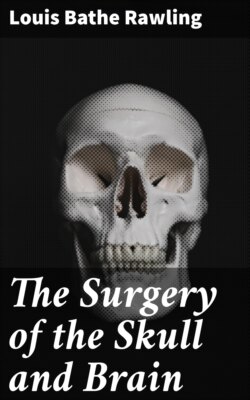Читать книгу The Surgery of the Skull and Brain - Louis Bathe Rawling - Страница 28
На сайте Литреса книга снята с продажи.
ОглавлениеFig. 4. The Scalp-tourniquet. Front View.
Fig. 5. The Scalp-tourniquet. Back View.
There is one other exception to the satisfactory working of the scalp-tourniquet. In the presence of a superficial cerebral tumour, especially when of a malignant nature, the normal communication between the intra- and extra-cranial vascular systems may be so exaggerated that those scalp-vessels which receive diploic and emissary venous communications will give rise to some trouble. This difficulty should be overcome—not by rapidity in the formation and turning down of the flap—but by clipping each vessel as exposed or divided, by the application of pressure and by foraminal occlusion (see also p. 17).
I found Cushing’s tourniquet rather inconvenient in its application, and, after various modifications, am accustomed to use the one depicted in the illustration. It consists of two flat metal bands connected posteriorly by a strong rubber connecting link, the two bands passing in front through a metal fixation piece possessing a screw which, when tightened up, allows of the maintenance of the desired pressure. The median tape, previously mentioned, helps to keep the tourniquet in position.
The tourniquet is applied as follows: the whole head is enveloped in gauze—two or three layers thick, and cut to the size and shape of a large handkerchief. The tourniquet is slipped over the head, as low down as possible, and then tightened up. The median tape, having a loop behind through which the tourniquet passes, is laid in the middle line and tied round the screw on the fixation piece.
The gauze should then be moistened with saline solution or some mild antiseptic, so that it clings tightly to the underlying scalp and becomes sufficiently translucent to allow of the recognition of any underlying landmarks that may have been previously mapped out with the scalpel, iodine, silver nitrate, or aniline pencil.
The scalp-flap is then framed by incisions carried down to the bone, through gauze and scalp, in one sweep. The flap is turned down and covered with gauze. By the adoption of this method hæmorrhage from scalp-vessels is efficiently controlled and the risk of wound infection is reduced to a minimum.
After the completion of the operation, the scalp-flap is approximated and sewn into position, first by numerous buried fine silk sutures bringing together the aponeurotic layer of the scalp, and finally by a few silk or salmon-gut sutures passed through the skin itself. Gauze dressings are applied, the tourniquet loosened, and a roll-gauze bandage quickly applied circumferentially around the head, low down over the forehead and occipital region. This roll bandage in reality takes the place of the tourniquet, but is, of course, applied with moderate pressure only.
If the wool and bandage now applied over all should include the ears, these two organs should be well covered with vaseline. Few things are more uncomfortable to the patient than the contact of wool and bandage to the ears.
The tourniquet should be utilized whenever possible. In operations, however, that are conducted near the base of the skull—subtemporal decompression, cerebellar exploration, &c.—the surgeon, in his effort at hæmostasis, must rely on the application of digital pressure on either side of the incision, the more careful exposure of the vessels, and the application of forceps as soon as they are seen or divided, or by the utilization of Vorschütz’s hæmostatic safety-pins.
Other methods of controlling scalp-bleeding are as follows:—
1. Kredel’s hæmostatic sutures, passed with a large curved needle which slides along the bone and emerges about 5 to 7 cm. from the point of introduction. The silk ligatures are then tied over metal plates, so curved as to lie flush with the surface of the skull in the particular region involved. Four of these plates would be used in the formation of an osteoplastic flap, one on the distal side of each of the three scalp incisions, and one along the base of the flap.
2. The enclosure of the proposed incision by a running suture which, passing down to the bone, emerges about 1 inch further on, then so to speak repeating itself in part until the whole region is surrounded. The ligatures are then tightened up. This method takes some time in its application, and presents no advantages over the scalp-tourniquet.
3. The blocking of the main arterial supply—temporal, occipital, and supra-orbital vessels—by modified safety-pins, mass ligatures, &c. Arterial compression by means of the modified safety-pin as suggested by Vorschütz will be found most useful in those operations in which the scalp-tourniquet cannot be utilized—subtemporal decompression, &c.
